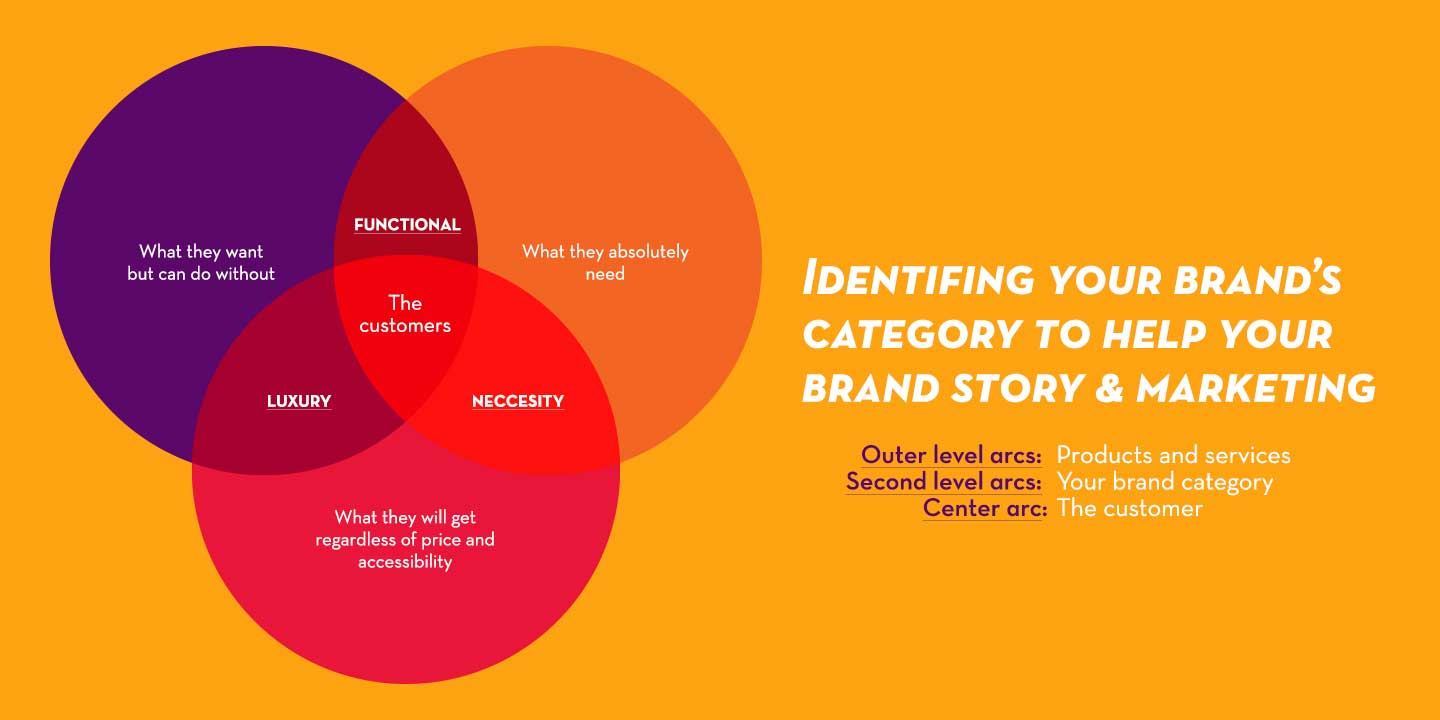Identifying your brand category to help brand story & marketing
Ever wondered why we associate certain items with brands? Brand category, that’s why.
When you study leading brands closely, you would discover the reason they dominate the market so well is, they have successfully established their brand category.
Think about consumables such as soft drinks, ice cream, and pizza, what comes to mind would be Coca-cola, Coldstone, and Dominos respectively, as a result of their clearly defined categories.
Brand categories are the pointers that consumers use to tick their purchase bucket list, and when a brand understands that consumers most likely choose a category that fits their desire before the products in the category, it would be easier to offer a great marketing story that converts. Finding a brand category can be very tricky, but when this is achieved, it could be the best thing to happen to a brand.
But,

What is a Brand category?
Brand categories are tags prospects use to organize brands into different sub-groups of related brands. For example, biology makes us understand that organisms are classified into living and non-living organisms, with these being the major categories before they are further broken down into other categories. This applies to products too. Brands from the same category have similar features and benefits. Companies with relating products offer customers similar benefits, resulting in competition in the market space.
Consumers are inclined to explore categories before choosing a particular brand in that category. For example, clothing items are in different categories – men wear, women wear and children wear. Other categories stem from either of the mentioned categories. The men’s wear category could have several sub-categories – casual, formal, and beachwear. These categories go on till they are exhausted.
Brand categories can be divided into sections – Necessity, Functional and Luxury brand categories.

Necessity brands:
These brands fulfill the everyday needs of consumers. Consumers purchase these brands without much thought. These brands’ offers are products/services consumers will purchase regardless of the changes in their income levels, therefore making these brands less sensitive to income change. These brands usually enjoy a higher advantage as their products/service experiences repeat purchase once the customer need has been satisfied at the first purchase. products in this category are food and groceries, education, housing, communication, medicine for individuals, software, or task-specific platforms for businesses and organizations. These products are oftentimes low priced relative to overall income/revenue which makes for a convenient buy.
Marketing Strategy –
Brands under this category need to position their products as the consumers’ go-to when they desire to satisfy their everyday needs. For Brands that fall under this category, it would be of interest to run a wide-scale promotion in order to build brand recognition because consumers usually do not bother price-checking a brand product once the brand has met their needs.

Functional brands:
Consumers buy these brands to satisfy their functional needs. These brands are only appealing to consumers if they solve an immediate need or desire for the right price. Customers do not think of these brand products unless a replacement is needed or a new need for one arises. Products like cell phones, pesticides, home appliances, and fire extinguishers are examples of functional products. Consumers purchase these brands because of what they can do, their inherent specifications, or what they offer.
Oftentimes functional brands don’t come to mind till the need or desire arises.
Marketing Strategy –
Marketing such brands would not be a walk in the park, as brands like this need to focus on differentiating features from competitors, price factors, performance, and value over other brands in that category.

Luxury brands:
Brands in this category offer products that are unique and consumers will go to extensive lengths to purchase them notwithstanding price and accessibility. Consumers purchase these brands partly for the unique and exclusive experience the products/services offer. But the key to the appeal of luxury brands is the inessential nature of their products or services and their extravagant cost. A luxury brand is desirable not just for the experience it provides but the value, status and style it offers. The set of customers interested in this category focus on seeking out specific products that matches their sophisticated lifestyle. The brand is thought to be expensive but not overpriced, of high-quality and long-lasting, but futuristic, aesthetically pleasing, but unique.
Marketing Strategy –
The change in how consumers define luxury and the new path to purchase is dramatically redefining the marketing strategy hence Luxury brands must be very agile and innovative in order to gain the favors of the new luxury consumer by investing in the development of outstanding and innovational products that will retain the loyalty of customers.
Sometimes a brand could conceivably be classified into two or more categories. But it would inevitably be more strongly associated in the consumers’ minds with one of them. It is very important to accurately define your brand category.
But…
How do you identify your brand’s category?
Identifying a category for your brand offers potential benefits such as the opportunity to establish compelling brand stories and formulate fail-proof marketing strategies.
A strong brand category also enhances a brand’s functionality. It shows consumers that the brand can offer solutions to their necessities and satisfy their wants.
The process of choosing a brand or product category can cause a lot of confusion, especially when these categories are not clear-cut. Some categories may differ from country to country. But the most important thing to remember when defining a brand category is to conduct thorough research beforehand.
There are several ways your brand can discover or define the ideal brand category;
- Create a list of possible categories for your brand. The list is determined by the values and benefits the brand offers to prospective consumers.
- Determine the words consumers associate the category with and if they consider other categories when searching for a solution.
- Examine your findings with surveys and keyword search engines.
- Confirm if your brand can compete in an existing category or there is a need to create a new one. To create a higher advantage, your brand can decide to offer consumers a better solution that they have not encountered before. This decision will result in advocating for both your brand and the category, but mostly the category.
- Ensure that once a category has been established, use vocabularies that consumers will associate your brand with, in your category statement. Communicate what your brand is and its similarities to other brands in the same category. If your brand isn’t where your target audience is looking, they will not find your brand.
- Optimize your website with your category name and description, as it ensures that visitors don’t guess what category your brand competes in. State your brand category explicitly.
In this post, the need for brand category and how to define your brand category were discussed. The point is to help you understand what you need to consider when trying to determine your brand’s category. A well-defined brand category helps consumers identify with your brand and eventually creates top-of-mind awareness when the need for brands in your category arises.
